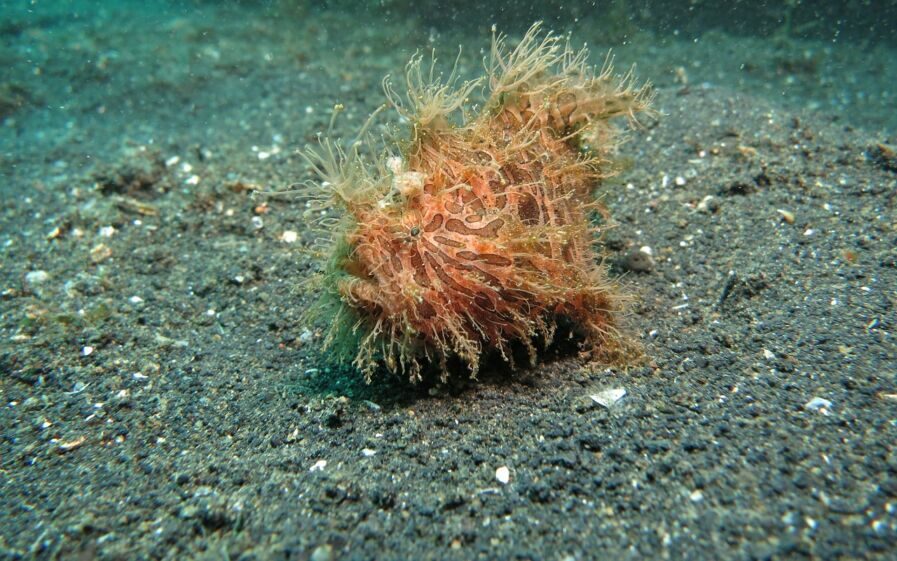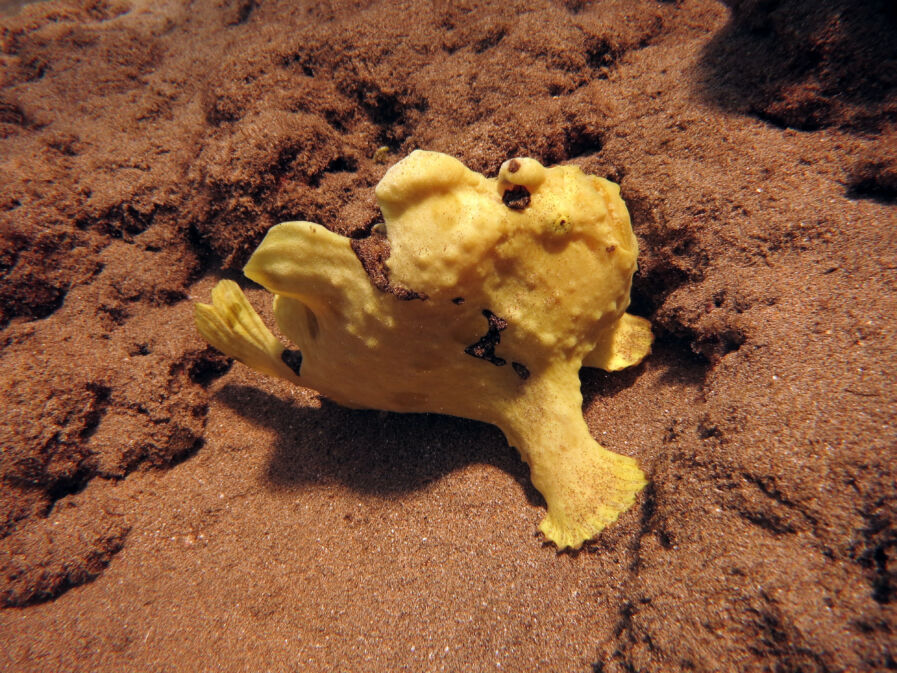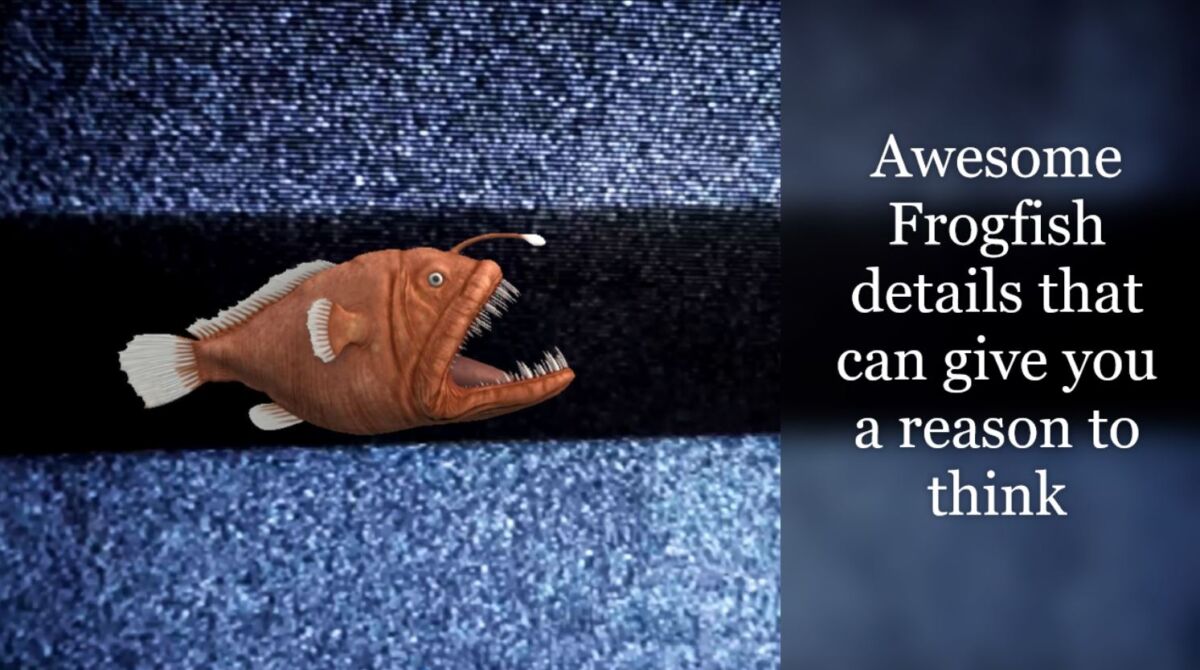Frogfish are not a very popular fish among people. Do not mistake this as non-talented or ugly. Nope!
They are amazing creatures. Knowing why it looks the way it looks & how? It can make you think. There is a purpose of this fish looking hairy or warty among its kind of species.
Frogfish are not a very popular fish among people. Please do not mistake it to be non-talented or ugly. Nope!
They are amazing creatures. Knowing why it looks the way it looks & how? It can make you think. There is a purpose of this fish looking hairy or warty among its kind of species.
Keeping in mind the place where they live in the shallow water, they are short and cute. Since they don’t swim like other Finn fishes, they have another speciality: jet propulsion movements. They are also small in size.

Wondering when was the frogfish discovered
A known belief is that it was before the 1630s.
Why do we say this?
An article from the University of Washington also shed more light on this topic. Theodore W. Pietsch is a professor emeritus from the University of Washington. He authored a book along with Rachel J. Arnold.
This book provides some valuable information on frogfishes and their lives. They are experts in this area of study.
We learn this part that says, “Accumulation of the knowledge of frogfishes”. This information further sparks a curiosity. Only when the knowledge accumulation of a specific creature starts that we can say about the discovery. Yet, we do not consider any layman’s or woman discovery or a personal experience. This one could have been forgotten and is not considered unless otherwise, it comes to light.
It may not always be the case because certain statements are also recorded just by people mentioning the story. We learnt that in the case of Kohinoor’s story, which was also a result of a short report by Theo Metcalfe.
In reality, we cannot deny the frogfishes sightings several hundreds of years ago and even before the 1600s. This statement may sound like a hypothesis, but we can’t say certainly. We can say that is because, at present, we learn a lot through scientific research work and studies. We understand the time frame, age & information through the fossil records. Yet, physical attributes, mention, the reporting, and the studies have come to our attention in stages.

Whether a scientist, zoologist, or an everyday angler, described it somewhat close to a fish with arms and legs or a growing in stages of frog (tadpole). Even Albertus Seba thought them to be amphibians.
How can we identify if Albertus Seba’s information on frogfish is something we could believe? Online you may find plenty of material that indicates their version to be true. Some are, whereas some aren’t.
Albertus Seba was a a scientist. What we know about frogfish lately is much more than earlier scientists. His mention of frogfish in Latin as Rana piscatrix already makes us understand that he knew how this frogfish was hunting its prey. Rana piscatrix, a Latin translated into English, means “The frog angler”.

Then a coloured picture by Luis Reynard of 1719 (The mention of it being Sambia or Loop-visch). Then we can also see an illustration of George Shaw from 1794 from Ted Pietsch’s book. There are now only 50 – 60 species of frogfish that we are aware of. Daniel Geary from Atmosphere Resorts in the Philippines has a brilliant article on the history of Frogfishes.
Who discovered the frogfish?
The person who first discovered the frogfish is not known, nor do we find any visible reports.
Do frogfish live in freshwater?
They can live in freshwater since there are freshwater frogfishes too. Mainly they are marine (Saltwater fish). They can also live in brackish water (slightly salty). Our research shows it to be from wild Indonesia. They are even sold online as aquatic livestock for aquariums.
The difference between angler fish and frogfish
Angler fish lives in the deep waters of the Antarctic & Atlantic oceans. The depth at which it stays varies based on each research. As mentioned, some have 3000 feet depth, whereas others have 6600 feet. Frogfish lives in Shallow waters that are tropical and subtropical.
A confirmed story of two snorkelers that came across strange-looking fish
Two snorkelers in New Zealand came across this two-legged fish while fishing boat. The story got published in Men’s Journal. He said he caught the fish, and while adding it into the live well, it started to move on its two legs. The story mentioned that it was fast, like a bullet attacking its prey in 6 milliseconds.
We also learn that the Museum of New Zealand Te Papa Tongarewa mentioned the frogfish. While placing the image on their Facebook page, they also communicated vital information; a part of it that attracted our attention is the following -“Frogfishes have the fastest bite of any vertebrate. Their mouths expand at the speed approaching a .22 rifle bullet – and that’s in a medium 800x denser than air.”
We noticed two golden nuggets here.
- Attacking its prey in 6 milliseconds
- Mouths expand at speed approaching a .22 rifle bullet – and that’s in a medium 800x denser than air.”
They have bait on the head like an angler fish. It is due to it being from the family of angler fish that is Antennariidae of the order Lophiiformes. When we translate this Latin word Antennariidae, it means Lophiiformes into English. In simple & easy terms, it means getting something through some kind of trickery.
Hunting Strategy of frogfish
They certainly are not very social. These fishes hunt alone, usually sitting still and waiting for their prey when they wiggle their lure on top of their head.
What do frogfish actually eat?
They can eat fish and crustaceans; however, they can even eat their fellow frogfishes acting like cannibals. Their menu consists of even Flounders, pufferfish, lionfish, damselfish, cardinal fish & many more creatures. They use camouflage to protect themselves from predators, such as Moray eels.
A particular action I observed after watching these frogfishes hunt their prey. Once it gulps the victim alive, you see some fish scales blown out of its mouth. If you haven’t noticed this, then please go ahead and watch.
Can we eat frogfish?
Nope! Not a single evidence or video that we came across where we see anyone eating a frogfish. I wouldn’t want to give it a try. Thanks
What is unique about a frogfish?
Their hunting technique is something that we can call unique.
Are frogfishes masters of disguise?
Nope, They aren’t! They can’t mould themselves and change their colour. The star master of disguise we know is Octopus. However, some species of frogfish change their colour and use appendages to camouflage. However, a change of colour for some species may take a few days.
What consists of being a master of disguise for the sea creatures?
- Change of Shape (Shapeshifters)
- Brainy Moves
- Changes its colour instantly
- Have advanced hunting techniques & tools as body parts
How do we identify a frogfish?
We identify a frogfish by a couple of visible signs such as
- Dangling lure on its head
- Hairy or warty
- Even similar to a sea sponge
- It doesn’t swim like other finfishes
- They don’t have the kind of teeth that can chew
Are frogfishes cold-blooded?
Through our research, we learned that most fishes have temperatures similar to the temperature around them. Frogfish are not exclusively known to be cold-blooded fish. Many other fishes are cold-blooded. A few of them we learn are warm-blooded.
As per NOAA, Opah fish is the only fish known to circulate warm blood. We also learn that some sharks and a few other fish, such as tuna, can also warm certain parts of their bodies. It enables them to move through the waters quickly.

